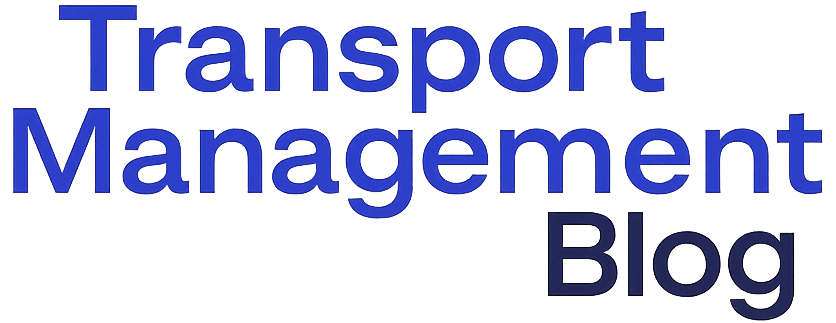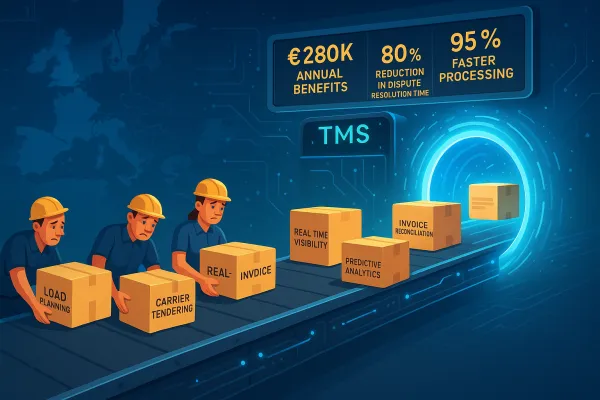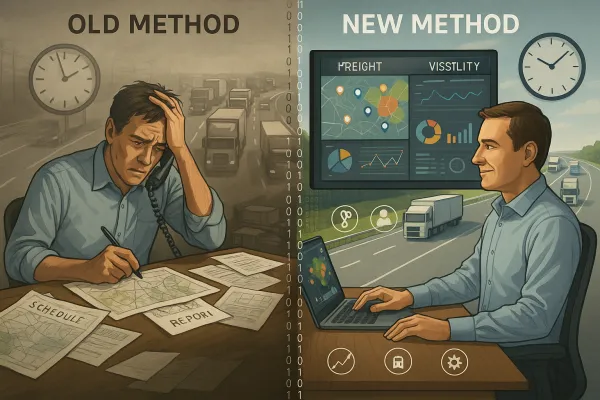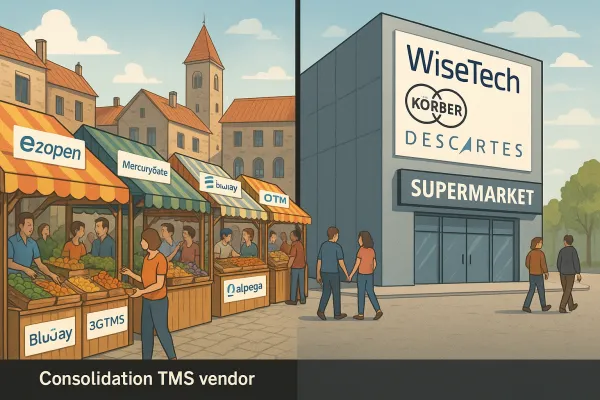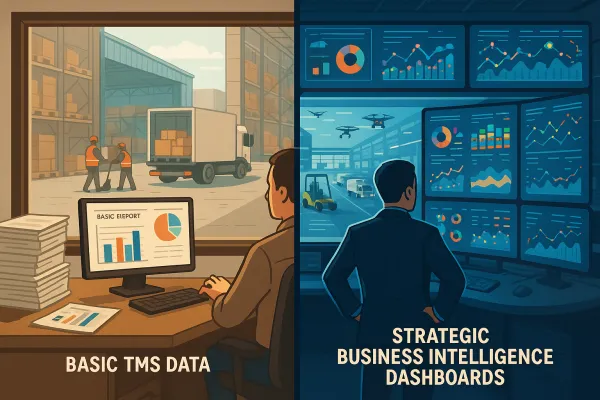The European Shipper's Compliance Transformation Guide: How Modern TMS Platforms Turn 2025's Regulatory Burden into Competitive Digital Advantage
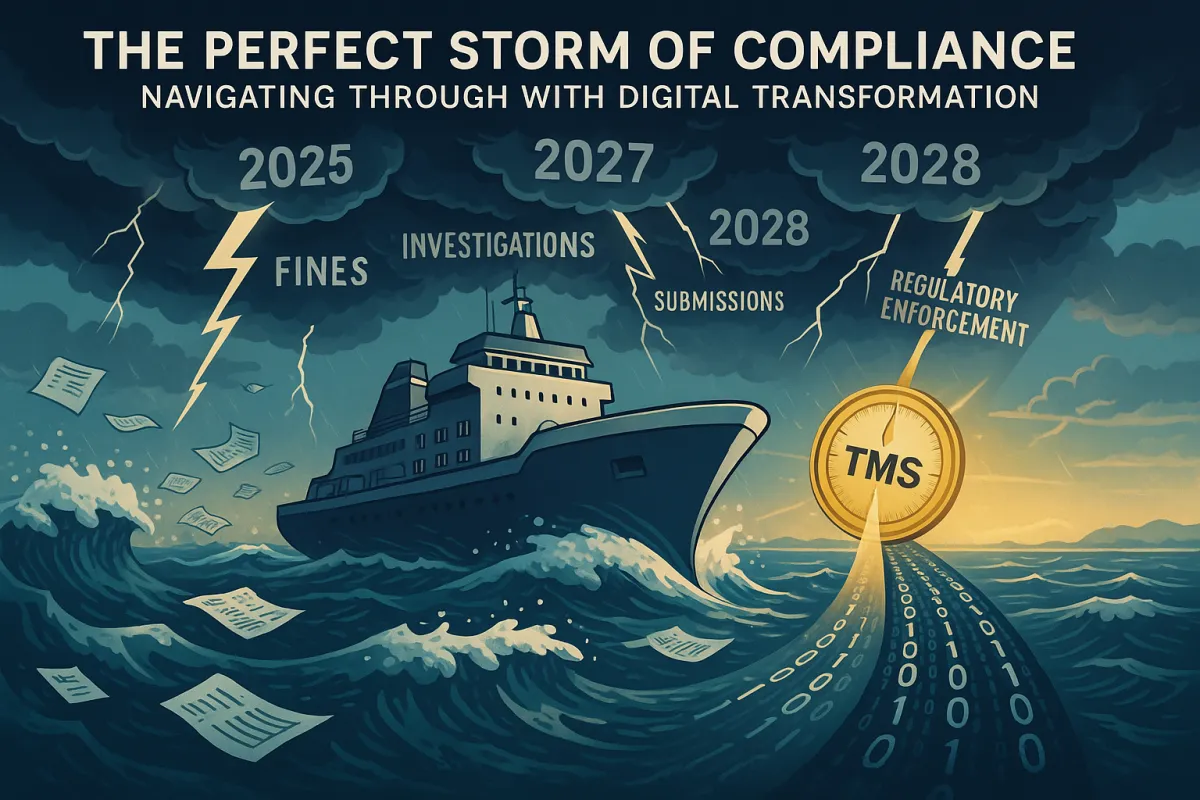
When CS3D entered into force on July 25, 2024, European shippers gained something they've been dreading: another compliance deadline. But here's what most missed - the first wave of CS3D compliance has been delayed from July 2027 to July 2028, and the Commission adopted an Omnibus package in February 2025 to simplify due diligence requirements. This isn't just another regulatory burden to manage. It's the forcing function that's finally pushing European transport operations from manual spreadsheet chaos into the digital age - and the companies that get there first will own a massive competitive advantage.
Add CBAM compliance and EU Deforestation Regulation deadlines, and we're looking at a regulatory perfect storm that will face numerous compliance challenges, including transparency and cooperation issues with business partners across the supply chain. The question isn't whether you'll need to automate these processes - it's whether you'll do it before or after your competitors.
The 2025 Compliance Perfect Storm Hitting European Shippers
The numbers tell a harsh story. The CS3D imposes specific due diligence obligations on companies that for two consecutive financial years meet the following criteria: EU companies with a minimum of 1000 employees and a net worldwide turnover of a minimum of 450 million euros. CS3D applies to companies with more than 1,000 employees on average and a net worldwide revenue exceeding 450 million euros. That's thousands of European manufacturers and large retailers suddenly facing mandatory human rights and environmental due diligence across their entire value chains.
Sound familiar? You're probably already dealing with tachograph compliance, driver working time regulations, and the EU Mobility Package. Now multiply that by ten. Large companies (5,000+ employees, €1.5 billion+ annual revenue) must comply by early 2027, medium-size companies (3,000 employees, €900 million annual revenue) by early 2028 and small companies (1,000 employees, €450 million) by early 2029.
The penalty structure makes this crystal clear: companies can face a range of adverse consequences for non-compliance, including regulatory investigations and enforcement, complaints/regulatory submissions by concerned persons, hefty fines. We're talking about penalty levels set at 4,250 euro per gCO2/tkm, starting from 2025 for heavy-duty vehicle CO2 compliance alone.
But here's the kicker: CS3D affects many more companies than those that fall directly covered, as companies directly covered must obtain contractual assurances and extensive information from their business partners to ensure compliance. As a result, almost all companies in the EU and many in third countries will be affected.
The Hidden Cost of Manual Compliance: Why Spreadsheets Are Your Biggest Risk
Want to know what inefficiency looks like in hard numbers? More than a fifth (21.2%) of the total distance traveled by road freight in the bloc last year was empty miles. At the EU level, approximately one-fifth of total road freight vehicle kilometers are carried out by empty vehicles (21.8%). That's not a rounding error - that's billions of kilometers driven with zero cargo, zero revenue, but full compliance obligations.
Think your transport team has bandwidth for manual compliance reporting? In the EU, trucks clocked up so-called "deadhead" distances of around 34 billion kilometers (21 billion miles) in 2021. Each of those kilometers generates data points you need to track, report, and audit under the new regulations.
The manual approach simply doesn't scale. approaches to climate and transition plans vary significantly between the CSRD, CS3D, Emissions Trading systems, creating confusion for the user regarding correctness and relevance of the disclosed CO2 emissions. This limits comparability and leads to confusion for the user regarding correctness and relevance of the disclosed CO2 emissions. At the same time, it also creates additional costs for the preparer due to multiple reporting processes and audits.
Here's what manual compliance really costs: Empty miles mean less revenue for carriers. It means increased costs because an empty truck on the road still consumes fuel, still needs a driver, and still requires regular maintenance. If the carrier isn't making money, it means the carrier is losing money — and a lot of it. Now multiply that inefficiency across every transport process that needs compliance tracking.
How Modern TMS Platforms Transform Compliance from Burden to Advantage
The market has spoken: The global transportation management system market size was estimated at USD 15.88 billion in 2024 and is estimated to reach USD 41.57 billion by 2030, growing at a CAGR of 17.5% from 2025 to 2030. Europe holds a substantial portion of the global TMS market, with an estimated market share of 28% in 2024.
Why this explosive growth? Europe transportation management system industry is expected to register a moderate CAGR from 2025 to 2030, fueled by the region's strong focus on sustainability, cross-border trade, and regulatory compliance. The demand for transportation optimization tools is rising due to increasing environmental concerns and the EU's emphasis on reducing carbon emissions in logistics. The adoption of electric vehicles and multimodal transport networks is also driving the need for more dynamic and integrated TMS solutions.
Modern TMS platforms aren't just about route optimization anymore. They're compliance engines that automatically capture, process, and report the data you need for CS3D, CBAM, and deforestation regulation compliance. Europe's push for digital transformation across the logistics sector is accelerating cloud-based TMS deployment.
The integration capabilities make the difference. While you're manually collecting compliance data from multiple carriers and systems, competitors using modern TMS platforms have automated workflows that capture emissions data, supplier compliance certificates, and due diligence documentation in real-time. Businesses are increasingly adopting TMS platforms to optimize routes, reduce carbon emissions, and comply with stringent regulatory standards related to transportation and logistics. The integration of IoT, AI, and machine learning technologies in TMS is driving the market forward by offering enhanced control and insights into operations.
The Digital Compliance Technology Stack: Essential TMS Features for 2025
Not all TMS platforms are built for European compliance reality. You need systems with built-in modules for:
Automated Emissions Tracking: CBAM compliance requires precise CO2 calculations for every shipment crossing EU borders. Leading platforms like Descartes Systems Group, Oracle Transportation Management, and SAP Transportation Management now include automated carbon footprint calculation engines that integrate with carrier systems.
Supply Chain Due Diligence Workflows: CS3D compliance means tracking human rights and environmental practices across your entire value chain. Companies must establish and maintain due diligence processes to monitor and address risks within their operations. Policy Integration: Embedding due diligence into corporate strategies and governance should be carried out to ensure continuous evaluation of risk.
Document Management and Audit Trails: When regulators come knocking, you need instant access to compliance documentation. Modern TMS platforms maintain complete audit trails of every transport decision, carrier selection, and route optimization. European solutions like Transporeon and Cargoson excel at this level of documentation.
Cloud-based platforms provide the scalability European companies need. Software-as-a-Service (SaaS)-based TMS is becoming more popular because the SaaS delivery model is flexible and costs less than other options. A big part of the global TMS market is made up of cloud-based services.
The key differentiator? Real-time visibility powered by microservices architecture. Platforms like MercuryGate and nShift now offer granular tracking that feeds directly into compliance reporting modules. Chinese parcel networks rely on AI route sequencers that compress urban lead times to under two hours. Indian manufacturers adopt TMS to orchestrate multimodal moves across fragmented infrastructure, balancing cost and service.
Implementation Strategy: Building Your Compliance-Ready TMS
Skip the big-bang rollout. June 2025: Modern Transportation realised USD 5 million annual savings after adopting BeyondTrucks multi-tenant TMS. May 2025: Uber Freight launched an AI logistics network comprising 30 autonomous agents, processing USD 1.6 billion in freight for clients including Colgate-Palmolive. April 2025: AROBS Transilvania Software posted RON 415 million turnover for 2024 and acquired SVT Electronics to deepen logistics technology capabilities. March 2025: Omniful enhanced cloud TMS for e-commerce fulfilment with expanded fleet-management and live-tracking features.
Start with your highest-risk compliance areas - typically cross-border shipments where CBAM applies immediately. The push for Industry 4.0 and smart factory integration is fostering the use of advanced TMS for end-to-end supply chain visibility. Furthermore, the presence of leading logistics service providers and a mature IT infrastructure creates favorable conditions for TMS adoption, especially those offering integration with ERP and WMS systems.
Integration planning determines success or failure. Your TMS needs to connect with existing ERP systems, carrier portals, and customs platforms. Solutions like Cargoson specialize in European market integrations, while enterprise platforms like Oracle TM and SAP TM offer broader ERP connectivity.
Change management matters more than technology selection. These companies are focused on innovation, offering cloud-based solutions, AI-driven technologies, and enhanced supply chain visibility to meet the evolving needs of global businesses. Your transport teams need training on compliance workflows, not just system features.
ROI Calculator: Quantifying the Compliance Automation Investment
The math is brutal if you don't automate. Manual compliance typically requires 1-2 additional FTE positions per major compliance framework. At €60,000 annually per FTE, you're looking at €120,000+ in staffing costs alone - before considering the error rates and audit risks of manual processes.
Compare that to cloud TMS costs: The Transport Management System market is projected to grow from USD 26,732 million in 2024 to USD 68,588.55 million by 2032, at a compound annual growth rate (CAGR) of 12.5%. The Transport Management System (TMS) market is driven by the increasing need for efficient logistics, cost reduction, and improved supply chain visibility. As businesses seek to streamline their operations, TMS solutions offer real-time tracking, route optimization, and enhanced decision-making capabilities, leading to reduced operational costs and improved customer satisfaction.
Penalty avoidance alone justifies the investment. No mandatory financial penalties based on a company's net global turnover will be imposed. These will be replaced with a requirement that the Commission work with Member States to set guidance for appropriate penalties. Even with simplified penalties, non-compliance costs dwarf automation investments.
Operational efficiency gains compound over time. Companies using automated compliance reporting typically see 15-30% reduction in transport administrative overhead, plus the hidden benefits of better carrier negotiations when you have clean, automated data to support your tenders.
Future-Proofing Your Compliance Strategy
In February 2025, the Commission adopted an Omnibus package to simplify due diligence requirements, and these adjustments could generate annual savings of €6.3 billion for affected businesses. But simplification doesn't mean elimination. The due diligence reform (CS3D) focuses on simplifying requirements for large companies and their business partners. Under the new framework, in-depth assessments of value chains beyond direct business partners (Tier 1) will only be required if tangible elements indicate a proven risk. The due diligence process will be streamlined to ease compliance obligations and provide greater predictability for affected companies.
The AI-driven automation trends accelerating across European logistics will make manual compliance even more obsolete. The incorporation of artificial intelligence (AI) and machine learning into TMS solutions stands out as a prominent trend. This integration empowers businesses with predictive analytics and data-driven decision-making capabilities, ultimately leading to the optimization of routing and scheduling processes.
Your digital transformation roadmap should anticipate additional regulations, not just current ones. The platforms making the biggest gains in Europe - from established players like Descartes to specialized solutions like Cargoson - are building compliance modules as core features, not afterthoughts.
The companies that automate transport compliance in 2025 won't just avoid penalties. They'll have cleaner data for carrier negotiations, faster response times for regulatory changes, and most importantly - transport teams focused on optimization instead of paperwork. Our hope for [the] future is that we — and others in our industry — are able to not only reduce empty miles, but to chip away at the distrust between parties, create visibility into supply and demand, and develop a transparency that can address deep-rooted supply chain inefficiencies.
The 2025 compliance deadline is coming whether you're ready or not. The question is: will you meet it with automated systems giving you competitive advantage, or manual processes keeping you busy while competitors pull ahead?
